2024..01.01.20
Files > Conference Series > 2024 > Chimboazo ild pagina nueva
Determination of water quality through using bioindicators, physical-chemical and microbiological analysis of the lagoon Santo Domingo of the national park Cotopaxi, province of Pichincha, period 201
Karen Nathali Ceballos Peñafiel *1, Moisés Alejandro Quishpe Guanoluisa 2.
1 Instituto Superior Tecnológico General Eloy Alfaro (ISTGEA), La Joya de los Sachas, 220101,
2 Instituto Superior Tecnológico General Eloy Alfaro (ISTGEA), La Joya de los Sachas, 220101 [email protected]
* Correspondence:[email protected] ; Tel.: KC: 0988096244
Available from. http://dx.doi.org/10.21931/BJ/2024.01.01.20
ABSTRACT
The current research project carried out in the Santo Domingo Lagoon of the Cotopaxi National Park, a Protected Area that is located in the canton of Mejia, province of Pichincha, and retains their transcendental goal to determine the water quality from the application of bioindicators and physical-chemical and microbiological laboratory analysis.
They obtained results about the quality of water using bioindicators according to the methodology used (scientific induction, inductive, deductive, measurement, quantitative), where samples were taken at five specific points of entry and exit of the lake body in April, May and June, making use of water quality identification techniques for tolerance; Biological Monitoring Working Part (BMWP/Col.), Ephemeroptera, Plecoptera, Tricoptera (EPT), Andean Biotic Index (ABI), and Biotic Index of Families (IBF). Meanwhile, the environmental quality indices were used for the physical, chemical and microbiological analysis: DINUS - Fundación Nacional de Saneamiento (NFS), defining that the water conditions are wrong or contaminated. By contrast, from the application of the BMWP/Col. and ABI indices, the water quality pertains to waters of questionable and critical condition.
However, with the application of the BMWP/Col. and ABI indices, it was defined that the water quality corresponds to waters of doubtful and critical condition, which are, in conclusion, very contaminated waters.
On the other hand, one of the techniques for using bioindicators from the IBF index yielded a different result in areas of apparent organic contamination, determining that the Santo Domingo Lagoon demonstrates an "excellent" indicator.
Keywords: water, analysis, bioindicators, quality, indices, lagoon
INTRODUCTION
Ecuador, recognized as one of the megadiverse countries on the planet due to its varied geography and geographic location, hosts a wide range of climates and ecosystems. Promoting the preservation of these valuable natural resources at our disposal is imperative.
The Ecuadorian Environment Ministry, in their commitment to promoting the conservation of ecosystems and their valuable goods and services, manages the National System of Protected Areas (SNAP), intending to ensure their care, preservation and sustainable management.
In this context, the Santo Domingo lagoon, located within the System of Protected Areas of Ecuador, specifically in the Cotopaxi National Park (PNC), has been identified as the object of the present investigation. Surprisingly, up to this point, no previous research has been conducted in this environment, which lends significant value to the present study in its efforts to promote the conservation of the water resource it houses. In addition, the findings of this investigation will be of great use in making decisions regarding the use and exploitation of this resource, taking into account aspects such as environmental care and protection, preservation, human health, a guide for sustainable management, ecological condition indicators, contribution to scientific knowledge and awareness and
The main objective of this investigation is to collect precise information on water quality in Laguna Santo Domingo. For this purpose, various tools were employed, using macroinvertebrates and physical-chemical and microbiological analysis, which provided an accurate diagnosis of the conditions of the lake environment.
The methodology used included indices such as BMWP/Col, ICA - NFS, ICA-DINIUS, I. ABI and I. IBF, which facilitated obtaining data on the water quality of Laguna Santo Domingo. The results indicated that the waters of this lake can be used for recreational purposes, which is supported by their membership in the National System of Protected Areas (SNAP)2.
It is essential to mention that the execution of this research faced various difficulties and challenges, including the remote location, adverse weather conditions, and the problematic access routes to the lake, which is situated at an altitude of 4005 meters above sea level.
MATERIALS AND METHODS
Inductive Method
The observation was strategically planned to draw universal conclusions from the specific data gathered within the study area, namely the Santo Domingo Lagoon in Cotopaxi National Park.
Deductive Method
With this method, the data from water samples collected at Santo Domingo Lagoon during fieldwork were analyzed to generalize to other fields, based on logical reasoning or conjecture, and propose conclusions.
Method of scientific induction
It was carried out from the study of the Santo Domingo Lagoon of the Cotopaxi National Park through this scientific induction that facilitated the support of empirical methods such as the observation of biodiversity in the surroundings of the study area.
It was carried out from the species register to determine the abundance and sensitivity, from the degree of tolerance to pollution, through the scientific study of the collected species.
Measurement method
A precise observation was made of the presence of a specific property and quality of each species observed in each of the sampling points that were carried out in the Santo Domingo lagoon, attributing numerical values, levels of tolerance and relationships to evaluate them, which allowed represent them adequately, in the results of the present investigation.
Quantitative method
This method was carried out in the count of each individual identified in the study area, the classification into categories according to the taxonomic characteristics found and the valuation of the water quality index, elaborating calculations by recording data from figures.
Descriptive research
The results of the water samples obtained in April and June 2018 from Laguna Santo Domingo were interpreted correctly, and the following types of studies were included: investigative and laboratory analysis. The quantitative and qualitative indicators obtained through the collection of species were classified. The information was organized in distribution tables, that is, the description, record, analysis and interpretation of the actual nature, the relevant, characteristic, specific and distinctive aspects of each species found to determine their classification.
Explanatory research
By conducting this type of study focused on the application of different indicators (I. ICA-NSF, I. EPT, I. ABI, I. BMWP/Col, ICA-DINIUS and I. IBF), applied and identified methods to obtain accurate information on water quality of Laguna Santo Domingo in the period of evaluation April (rainy), May (transition) and June (dry - summer).
An explanatory investigation was developed because the Santo Domingo Lagoon is poorly studied and has little information; primordial in the study of macroinvertebrates allowed us to obtain data that facilitates determining their water quality.
Bibliographic research
This type of research allowed us to obtain necessary information about the water quality of Santo Domingo Lagoon since it provided the knowledge for the development of the research project, including the formulation of hypotheses and comparison of results obtained. Information about macroinvertebrate species was sought through various means such as book reviews, bibliographic references, the internet, etc., 3.
Field Investigation
The study was conducted directly in the natural environment where the phenomenon under investigation occurs. This involved the collection of water samples and macroinvertebrates.
According to the objectives of the investigation, the established was executed to be able to perform the determination of the sampling points in the work area, using programs like GPS, Google Earth Pro, SAS Planet, and ArcGIS; this enabled the monitoring of macroinvertebrate species and the collection of water samples from both the main inlet and outlet of the tail.
Observation
Direct observation was conducted in the study area (Santo Domingo Lagoon), where macroinvertebrates and water samples were collected, respectively, to obtain the most effective data for the research.
Structured observation was carried out with the help of appropriate technical elements such as forms, charts, and tables.
Field observation: Field observation was performed during the collection of species and in-situ water sampling at Santo Domingo Lagoon.
Water Sampling (physical-chemical and microbiological analysis): A representative portion of a water mass was extracted to examine various characteristics. The Ecuadorian technical standard INEN 20169:98 specifies that sample containers for physical-chemical and microbiological analysis should be wide-mouthed containers, jars, or bottles made of either plastic or glass.
Protocol for taking water samples for physical-chemical and microbiological analysis
Field phase
The following protocol was applied with the sampling points identified for taking water samples in the main inlet and outlet of the lake of Santo Domingo immersed in the Cotopaxi National Park on April 9 and June 20, 2018.
Filling the container.
The water sampling was carried out in compliance with the Ecuadorian Technical Standard INEN 20169:98. To achieve this, the bottles from Laguna Santo Domingo were sterilized with water three times. Afterward, the bottles were filled and sealed underwater to eliminate air, preventing interaction with the gaseous phase and agitation during transportation to the laboratory.
Identification sample.
The water samples were identified and labeled with their respective date, time, point and place of sampling from which they were taken, allowing no margin of error in the laboratory.
Conservation technique
The samples obtained on the different sampling days were kept at 2 ºC and 5 ºC, kept in a cooler with a certain amount of ice that allowed them to reach said temperature; in contrast, the samples were transported to the laboratory.
Transportation sample
The containers with the water samples were protected and sealed to prevent them from deteriorating or losing any part of them during transport from the Santo Domingo Lagoon to the cities of Ambato (April) and Sangolqui (June), where they were found in the laboratory. During transportation, the samples were placed in a safe place to protect them from light and kept in a cool environment, separating each sample in a different impermeable container.
Laboratory stage
Reception sample to the laboratory.
Reception sample to the laboratory.
The samples were transported to the laboratory in the cities of Ambato and Sangolqui. The samples obtained from the monitors in April -09 and June -20, 2018 were preserved and deposited in refrigerators under conditions established in the Ecuadorian Technical Standard INEN 20169:98, preventing any external contamination and change in their content.
Table 1. Physical parameters, chemical and microbiological.
Collection of samples for the analysis of macroinvertebrates.¡
Field phase
The field phase was carried out in April - 09, May - 10 and June - 20 of 2018. At each sampling point, a transect of 30 to 50 meters was established, from which various specimens were collected for the respective samples. The collection technique with red Surber used a 250 μm aperture mesh with an area of 0.1 m2. This involves capturing the individuals, the same ones who were identified in the laboratory; if they used multiple bottles, each one was labeled with the date, time and point of sampling; therefore, in all the bottles in the monitoring and, or control area, the individuals of each group were identified and counted to obtain the total number of individuals (abundance) and do the same with all the bottles in the sampled area.
The technique involves introducing the net into the lake at a determined sampling point. He removed to remove and hit the substrate dynamically with his feet for approximately one minute. This was repeated in the five monitoring points in the Santo Domingo Lagoon, where the established climatic seasons (precipitation, transition and dry season) were monitored.
To obtain more precise information about the water quality conditions of the Santo Domingo Lagoon, the presence of macroinvertebrates, they will be collected in the Surber network if the macroinvertebrates are separated from the other animals with the help of Entomological forceps. The separated specimens were placed in bottles previously labeled with 96% alcohol for each sample. During the water body sampling, information was recorded in a notebook: geographic coordinates, date, time of sampling, climate, habitat, and description of the water body, among others.
With the help of the identification sheet, they grouped similar individuals, if they resembled which group they belonged to, and counted how many specimens each group had. This process was repeated with the macroinvertebrates collected in the other bottles from the different points.
The plates for identifying macro specimens will facilitate the identification of the most common groups found in rivers, estuaries and lagoons.
The Figure of each species of macroinvertebrate identified in the Santo Domingo lagoon allowed for obtaining the following information:
● Scientific classification.
● Local numbers.
● Figures or drawings that indicate the type of food and the place where you live.
● Furthermore, a number indicating the sensitivity of each macroinvertebrate to pollution
Laboratory stage
Once the samples of macroinvertebrates were transported to the laboratory, they used materials such as: a stereo microscope, Petri dishes and entomological tweezers to analyze the samples of aquatic macroinvertebrates obtained from the water body of Laguna Santo Domingo.
The specimens were identified in terms of order, family and gender with the help of field guides and relevant photographic guides 4. The samples allowed quantitative and qualitative analysis of each of the sampling points.
Sampling frequency
The field trips for the different samplings were carried out during the wet (April), transition (May) and dry (June) seasons of 2018, whose frequency of sampling was carried out once for me during a previously established period, where they have collected the samples for subsequent analysis.
Water quality indices
ICA
The ICA applied for the evaluation of the constituents that affect the water quality for their different uses and to summarize this evaluation in a simple value that served as a way to communicate and represent the water quality of the Santo Domingo lagoon. An Index of water quality (ICA) indicates the degree of water contamination in a specific sampling date and is expressed as a percentage of pure water; being so, highly contaminated water presents an ICA close to or equal to 0%, in contrast, water in excellent conditions will have an index close to 100% 2.
The NSF index (1978) is fundamental in the equation:

why,
● SI is from the subscript of the variable , y;
● Wi is from the weighted weight of subindex (Otto, 1978).
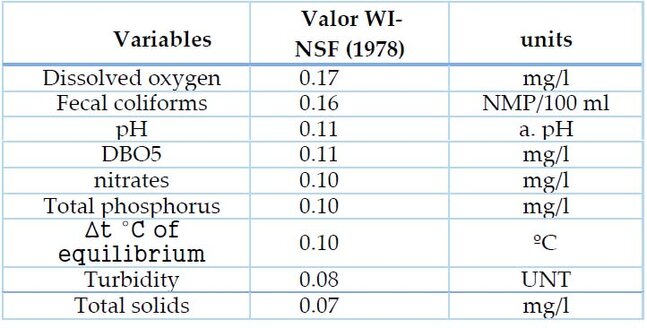
Table 2. ICA NSF established pesos and units.

Table 3. Characterization of results based on the NSF Index.
ICA - DINIUS
The study was carried out with the application of this index for the extensive use of physical, chemical and microbiological parameters, which allowed a detailed analysis of the water quality of the Santo Domingo Lagoon, concerning the tourist advantage, as it is found inside a protected area.
From the quality index of Dinius (1987), it is determined as:


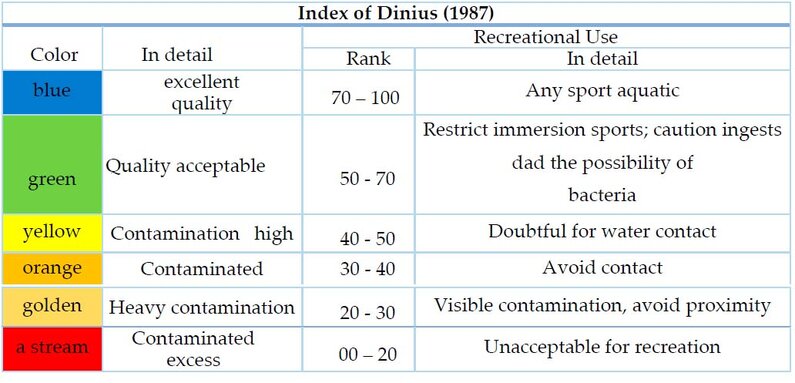
Table 4. Characterization of results based on the Dinius Index.
Analysis EPT
It was used to identify the presence of Ephemeroptera, Plecoptera, and Trichoptera in the Santo Domingo Lagoon, to determine the water quality of the said lake, Table of macroinvertebrate assessment and the following formula.
The calculation consists of dividing the corresponding Number of EPT present in the sample according to the total number of organisms:


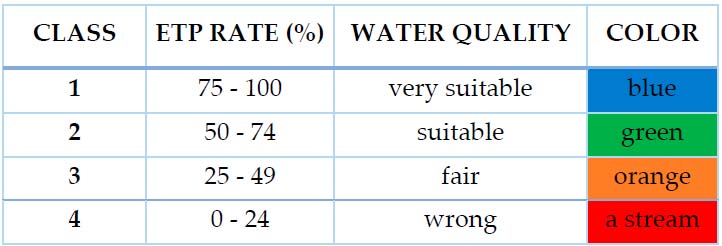
Table 5. Sensitivity of the macroinvertebrates.
Index BMWP/COL.
The BMWP/Col Index (Biological Monitoring Working Party) was used, from which values from 1 to 10 were assigned to macroinvertebrates identified at the family level. Those who do not tolerate the loss of water quality will be given high scores; in contrast, those who endure the loss of quality have low scores.
The total scores of all those found in a site were proportional to the value of the water property of Laguna Santo Domingo.
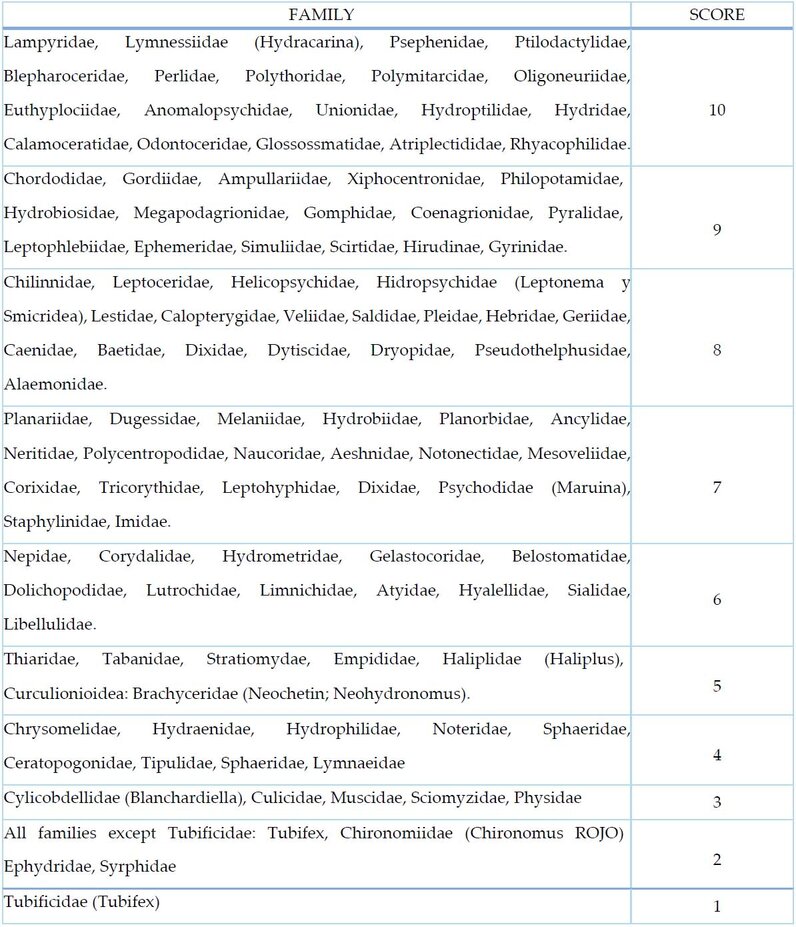
Table 6. System for Determining Biological Monitoring Index - BMWP (Biological Monitoring Working Party Score System) - Adaptation for Colombia.
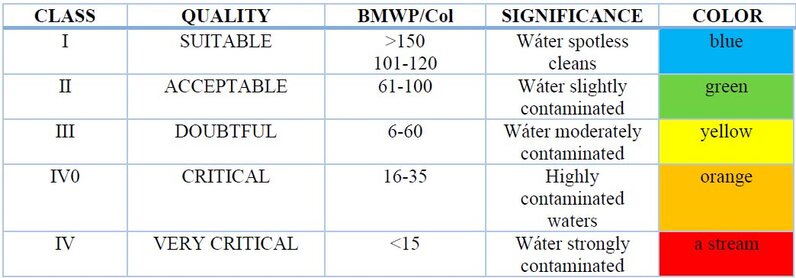
Table 7. Biological Quality of Water – Index BMWP/Col.
Index ABI
The Andean Biological Index made it possible to determine the quality of the water, which was determined through the use and identification of macroinvertebrates as natural aquatic bioindicators, assigning values from 1 to 10 to each family and the total sum of these values given in the identification stage of the macroinvertebrates from a specific value of the ABI index.
Understanding that this value should be divided by the resulting Figure of rates found at the monitoring site where the investigation is being conducted 6.
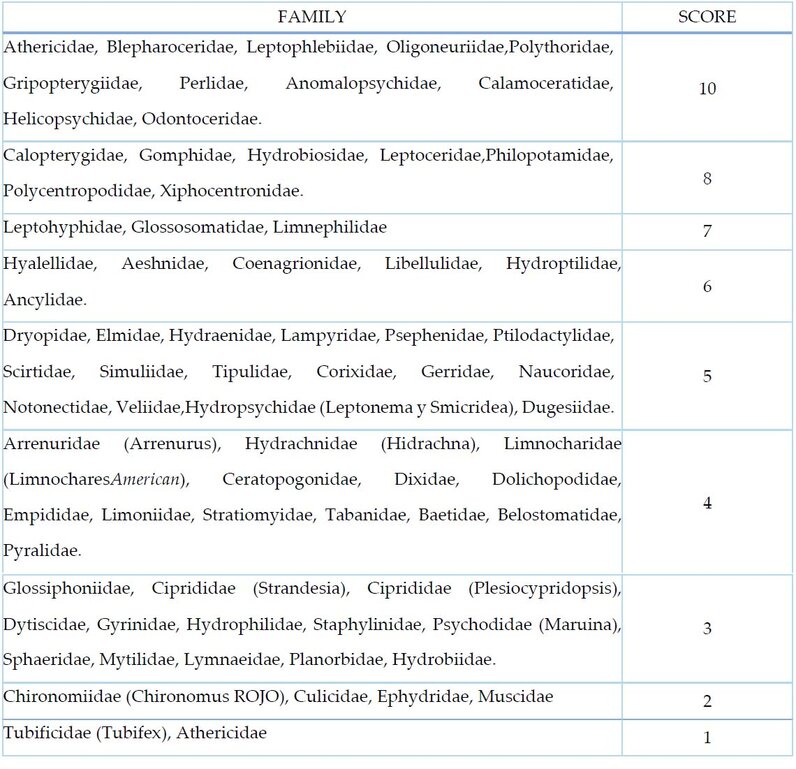
Table 8. Valorization of macroinvertebrates according to the ABI index.
A score that allowed determining the water quality according to the Andean Biotic Index (ABI).

Table 9. Score for the determination of water quality according to the ABI index.
Índice IBF (Biotic Index of Families)
The IBF index made it possible to evaluate the water quality of the Santo Domingo Lagoon, so this family biotic index was calculated as a weighted average of the abundance of different species of benthic macroinvertebrates. The weighting value measures the tolerance that each group presents to organic pollution. For each family, the tolerance score is multiplied by the number of individuals, and then the results of all families are added together 7.
To be able to use the IBF index, the following formula is used:


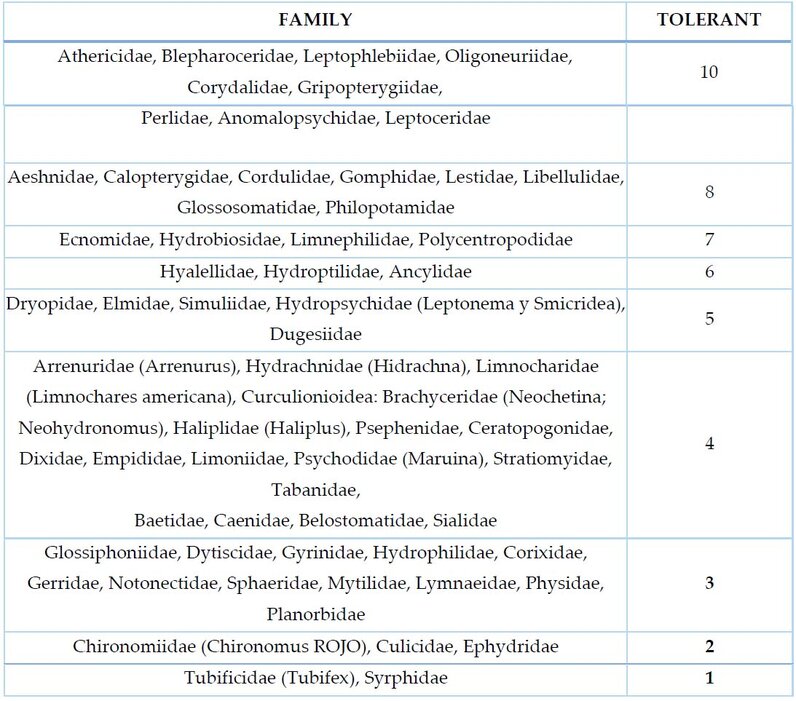
Table 10. Tolerance values of macroinvertebrates from the Biotic Index of Families.

Table 11. Quality classes for the Biotic Index of Families.
Instruments and materials
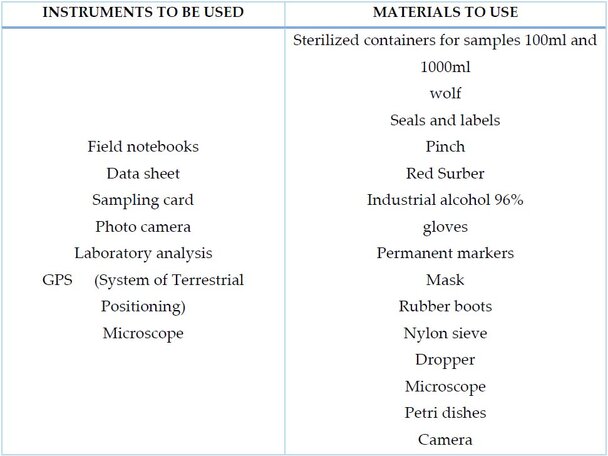
Table 12. Instruments and materials that were used in the research project.
RESULTS
Analysis ICA – INSF - April
SAMPLE WATER (1): MAIN ENTRANCE SANTO DOMINGO LAGOON – APRIL 2018
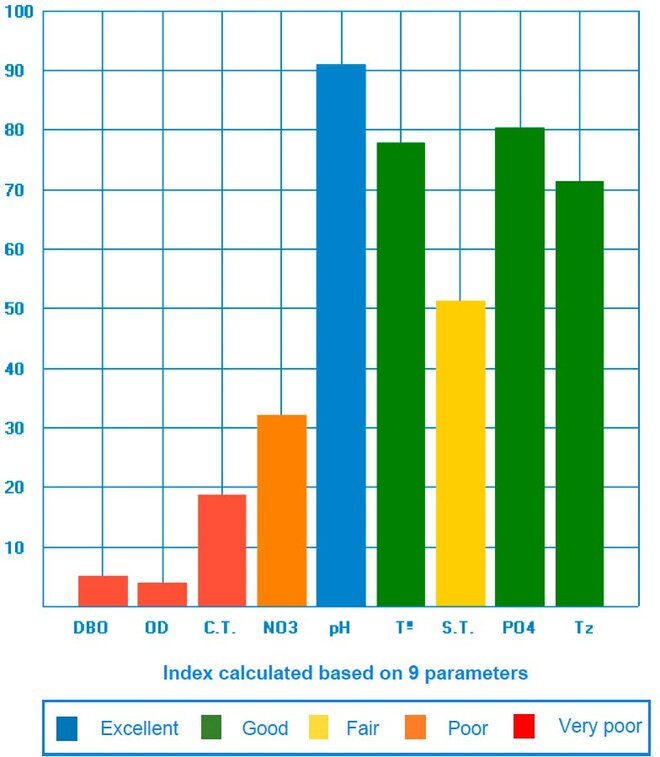
Figure 1. NFS Analysis - April - Q Values – Entrance.
The results obtained according to the analyzed parameters, the following values were obtained: (DBO – 52mg/L), (OD – 3.7 mg/L), (CF – 1800 NMP/100mL), (NO3 – 25 mg /L), (pH – 7.7 UnpH), (Tº - 3.8 ºC), (ST – 364 mg/L), (PO4 – 0.31 mg/L), (Tz – 12.3 NTU), and according to ICA Test - INSF we have that the quality of the water of Laguna Santo Domingo has an index value of 42.52 giving as a result a wrong qualification, each one of this qualification and, or weighting corresponding to each one of the parameters: DBO evil, OD evil, CF evil, NO3 wrong, pH excellent, T° suitable, ST average, PO4 suitable, and Tz suitable.
SAMPLE WATER (2): EXIT SANTO DOMINGO LAGOON – APRIL 2018
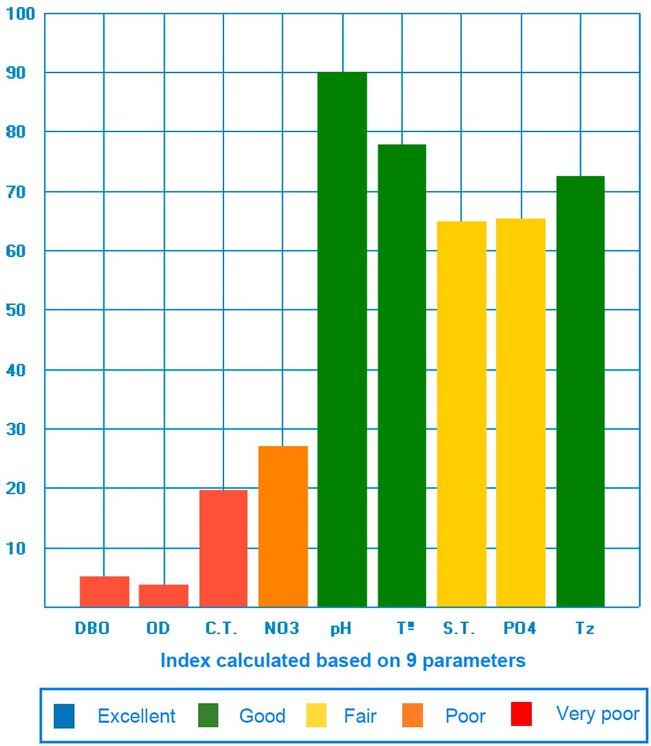
Figure 2. NFS Analysis - April - Q Values - Exit.
The results obtained according to the analyzed parameters, the following values were obtained: (DBO – 67mg/L), (OD – 3.2 mg/L), (CF – 1620 NMP/100mL), (NO3 – 30 mg /L), (pH – 7.8 UnpH), (Tº - 3.8 ºC), (ST – 258 mg/L), (PO4 – 0.45 mg/L), (Tz – 11.8 NTU) , according to the ICA Test - INSF we have that the quality of the water of the Santo Domingo Lagoon has an index value of 41.53 giving as a result a wrong qualification, each one of this qualification and, or weighting corresponding to each of them parameters: DBO evil, OD evil, CF evil, NO3 wrong, pH suitable, T° suitable, ST medium, PO4 medium, and Tz suitable.
- Analysis ICA – DINIUS - April
SAMPLE WATER (1): MAIN ENTRANCE SANTO DOMINGO LAGOON – APRIL 2018
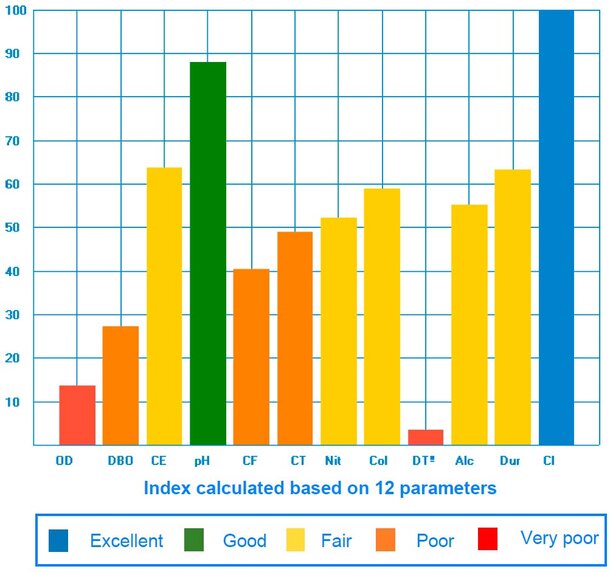
Figure 3. DINIUS Analysis, April - Q Values - Entrance.
The results obtained according to the analyzed parameters, the following values were obtained: (DBO – 52mg/L), (OD – 3.7 mg/L), (CE – 518.88 µΩ/cm), (CF – 1800 NMP/100mL), (CT – 2400 NMP/100mL), (NO3 – 25 mg/L), (Col – 25 Unid.), (Tº - 3.8 ºC), (Alc – 174 mg/L), (Dur. – 125mg/L), (Cl – 28 mg/L), and according to ICA Test – Indice DINIUS the water quality of Laguna Santo Domingo is 37.66, resulting in classification as contaminated, since it is evaluated for recreational use, for which each qualification and, or weighting of each parameter is: OD evil, DBO wrong, CE average, pH suitable, CF wrong, CT wrong, NO3 average, Col average, T° evil, Alc medium, Dur medium y Cl excellent.
SAMPLE WATER (2): EXIT SANTO DOMINGO LAGOON - APRIL 2018.
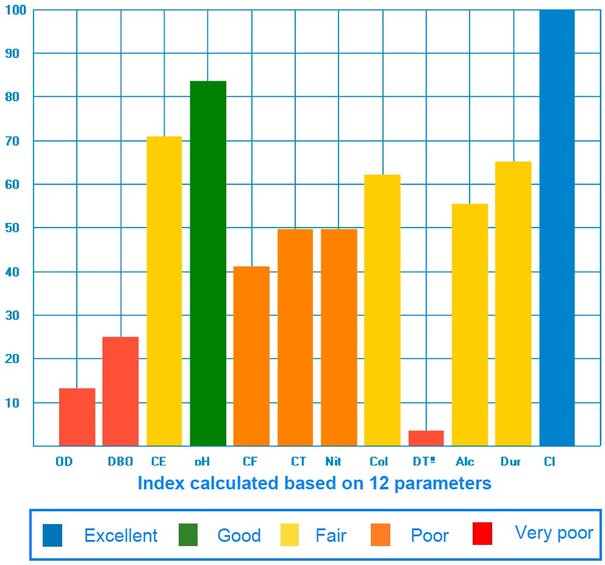
Figure 4. DINIUS Analysis, April - Q Values - Exit.
The results obtained according to the analyzed parameters, the following values were obtained: (DBO – 67mg/L), (OD – 3.2 mg/L), (CE – 376.6 µΩ/cm), (pH – 7 ,8 UnpH), (CF – 1620 NMP/100mL), (CT – 2150 NMP/100mL), (NO3 – 30 mg/L), (Col – 20 Unid.), (Tº - 3.8 ºC), (Alc – 165 mg/L), (Dur. – 117mg/L), (Cl – 24 mg/L), and according to ICA Test – DINIUS Index the water quality of Laguna Santo Domingo is 37.61, resulting in classification as contaminated, since it is evaluated for recreational use, for which each qualification and, or weighting of each parameter is: OD evil, DBO evil, CE medium, pH suitable, CF wrong, CT wrong, NO3 wrong, Col medium, T° evil, Alc medium, Dur medium and Cl excellent.
Analysis ICA – INSF - June
SAMPLE WATER (3): MAIN ENTRANCE LAGUNA SANTO DOMINGO - JUNE 2018.

Figure 5. NFS Analysis - June - Q Values - Entrance.
The results obtained according to the analyzed parameters, the following values were obtained: (DBO – 21mg/L), (OD – 69.58 mg/L), (CF – 140 NMP/100mL), (NO3 – 115 mg /L), (pH – 6.3 UnpH), (Tº - 6.8 ºC), (ST – 9 mg/L), (PO4 – 10 mg/L), (Tz – 121 NTU), and according to ICA Test - INSF the water quality of Laguna Santo Domingo is wrong has an index value of 40.47, being each one of this rating and, or weighting corresponding to each of the parameters: DBO evil, OD suitable, CF wrong, NO3 evil, pH average, T° average, ST suitable, PO4 evil, and Tz evil.
SAMPLE WATER (4): EXIT SANTO DOMINGO LAGOON - APRIL 2018
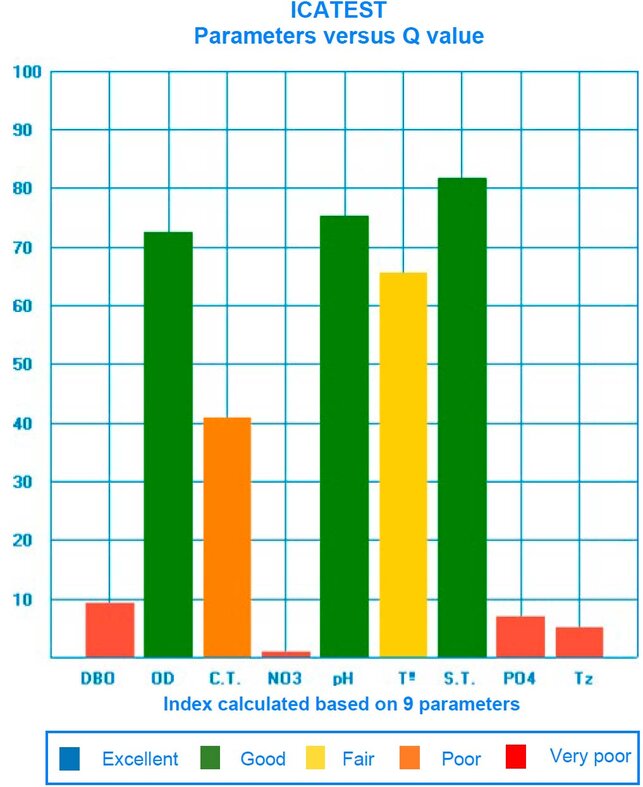
Figure 6. NFS Analysis - June - Q Values – Exit.
The results obtained according to the analyzed parameters, the following values were obtained: (DBO – 22.32 mg/L), (OD – 68.53 mg/L), (CF – 140 NMP/100mL), (NO3 – 116 mg/L), (pH – 6.6 UnpH), (Tº - 6.3 ºC), (ST – 9 mg/L), (PO4 – 10 mg/L), (Tz – 119 NTU), and according to ICA Test - INSF we have that the quality of the water of Laguna Santo Domingo has an index value of 41.64 giving as a result a rating of wrong, each one of this rating and, or weighting corresponding to each of them parameters: DBO evil, OD suitable, CF wrong, NO3 evil, pH suitable, T° medium, ST suitable, PO4 evil, and Tz evil.
Analysis ICA – DINIUS – June
SAMPLE WATER (3): MAIN ENTRANCE SANTO DOMINGO LAGOON - JUNE 2018
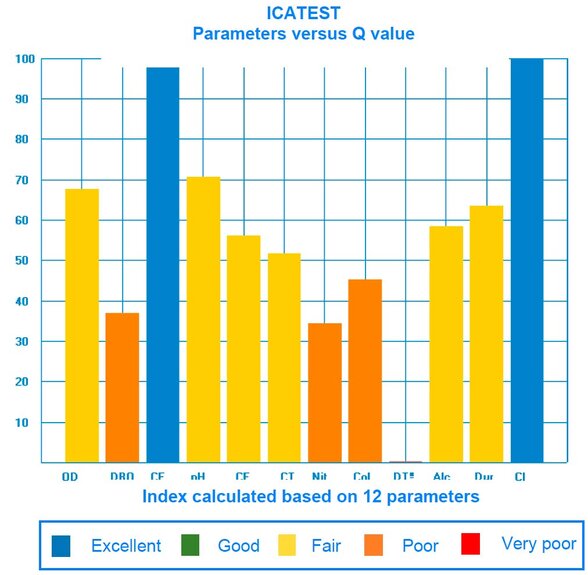
Figure 7. DINIUS Analysis, June - Q Values – Entrance.
The results obtained according to the analyzed parameters, the following values were obtained: (DBO – 21.42 mg/L), (OD – 69.58 mg/L), (CE – 19 µΩ/cm), (pH – 6.3 UnpH), (CF – 140 NMP/100mL), (CT – 1600 NMP/100mL), (NO3 – 115 mg/L), (Col – 75 Unid.), (Tº - 6.8 ºC), (Alc – 112 mg/L), (Dur. – 124 mg/L), (Cl – 19.74 mg/L), in where, according to the result of the ICA Test – DINIUS Index, the water quality of Laguna Santo Domingo is contaminated has an index value of 38.20, since it is evaluated for recreational use, for which each qualification and, or weighting of each parameter is: OD average, DBO wrong, CE excellent, pH medium, CF medium, CT medium, NO3 wrong, Col wrong, T° evil, Alc medium, Dur medium y Cl excellent.
SAMPLE WATER (4): EXIT SANTO DOMINGO LAGOON - JUNE 2018
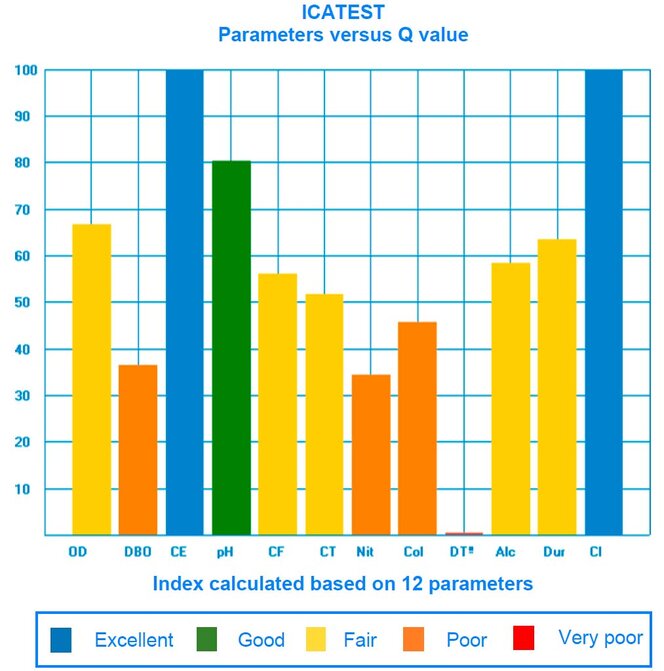
Figure 8. DINIUS Analysis, June - Q Values – Exit.
The results obtained according to the analyzed parameters, the following values were obtained: (DBO – 22.32mg/L), (OD – 68.53mg/L), (CE – 19 µΩ/cm), (pH – 6, 6 UnpH), (CF – 140 NMP/100mL), (CT – 1585 NMP/100mL), (NO3 – 116 mg/L), (Col –71 Unid.), (Tº - 6.3 ºC), (Alc – 112mg/L), (Dur. – 124mg/L), (Cl – 18.40 mg/L), and according to ICA Test – Index DINIUS we have that the quality of the water of Santo Domingo Lagoon has a value of an index of 39.93 result a qualification of contaminate, since it is evaluated for recreational use, for which each qualification and, or weighting of each parameter is: OD average, DBO wrong, CE excellent, pH well, CF average, CT medium, NO3 wrong, Col wrong, T° evil, Alc medium, Dur medium and Cl excellent.
Comparison of results between the ICA DINIUS and NFS in the Santo Domingo Lagoon
Main Water Inlet, April and June

Table 13. Results, ICA DINIUS and ICA NFS.
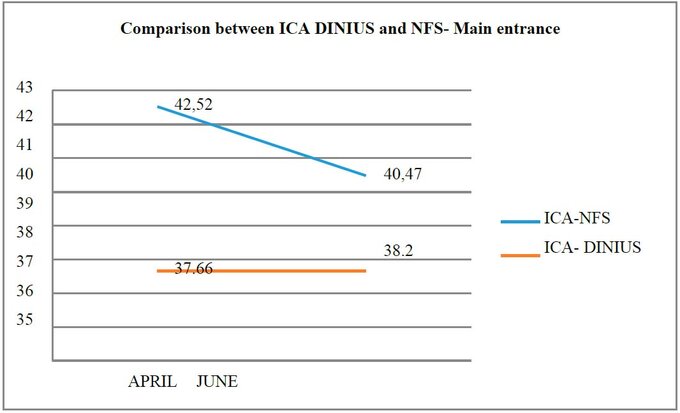
Figure 9. Comparison between ICA DINIUS and ICA NFS.
In Figure Nº9, it is expressed that in the months that water samples were taken for subsequent analysis (April and June), from the main entrance of the Santo Domingo lagoon, the results obtained were similar with ranks of between 37 and 42, justifying that the two indices determine that the water quality is wrong and, or contaminated.
Main Water Outlet, April and June.

Table 14. Results, ICA DINIUS and ICA NFS.

Figure 10. Comparison between ICA DINIUS and ICA NFS - Exit.
In Figure Nº 10, it is determined that in April and June, when the water samples were obtained from the main outlet of the lake, the results obtained were of a rank between 37 and 41, being similar to the results obtained from the analysis of the main entrance of the river, arguing that the two indices determine that the quality of the water is poor and, or contaminated.
Analysis of macroinvertebrates index EPT
In the monitored months (April, May and June), no families belonging to the EPT group (Ephemeroptera, Plecoptera and Trichoptera) were identified, so this index cannot be applied to determine the water quality index.
BMWP/Col index analysis:
In Table Nº 15, the water quality values are observed through the BMWP index with their respective class for each month of sampling (April, May and June).

Table 15. Water quality through the BMWP index.
In Table No. 15, it is stated that in the months of April and May, values were obtained with a similarity range of 24 and 30, which determine a class IV, indicating that the water is in a state of critical quality. In June, the index value was 37, resulting in the water quality being considered doubtful, corresponding to moderately contaminated waters.
According to the BMWP index, for April, 424 species were registered, among which 6 tolerant and sensitive families were identified, among them the sensitive families with values of 6 the Hyalellidae family, followed by the tolerant families with values of between 5 y 1: Notonectidae, Lymnaeidae, Cylicobdellidae, Glossiphoniidae and Tubificidae.
In the middle of May, the BMWP index was determined for 309 species of 7 families identified, tolerant and sensitive, among them the sensitive families with values of 6, such as the Hyalellidae family and increasing the Libellulidae family, followed by the tolerant families with values from between 5 and 1: Notonectidae, Tipulidae, Cylicobdellidae, Glossiphoniida and Oligochaeta.
The result obtained from the BMWP index for June was determined based on 338 species from 8 identified families, both tolerant and sensitive. The sensitive families to pollution, such as Hyalellidae, Notonectidae, Libellulidae, and Planariidae, had values of 7 and 6, respectively. This was followed by pollution-tolerant families with values ranging from 4 to 1: Cylicobdellidae, Glossiphoniidae, Tubificidae, and Lymnaeidae. This result differs from previous months, as an additional family sensitive to pollution was identified.
ABI Index Analysis:
In Table Nº 16, the water quality values are observed through the ABI index with their respective class for each month of sampling (April, May and June).

Table 16. Water quality through the biological index ABI.
Table Nº. 16 shows that similar values were obtained in April, May, and June, ranging between 21 and 32, categorizing it as Class IV, indicating poor water quality.
In April, according to the tolerance values of the ABI index, tolerant and sensitive families were identified, among them the family with a value of 6 such as Hyalellidae, followed by the tolerant families with values of between 5 y 1: Notonectidae, Lymnaeidae, Cylicobdellidae, Glossiphoniida and Tubificidae.
In May, two sensitive families with values of 6 were identified: Hyalellidae and Libellulidae, followed by five families tolerant to pollution with values of between 5 and 1, those Notonectidae, Tipulidae, Cylicobdellidae, Glossiphoniida and Tubificidae.
For June, eight families have been collected, of which two are sensitive to contamination, registered with values of six, those Hyalellidae and Libellulidae, continuing with the tolerant families which are primarily with values of between 5 and 1: Cylicobdellidae, Notonectidae, Glossiphoniidae, Tubificidae, Lymnaeidae, Planariidae.
Comparison between BMWP Index and ABI Index
Table Nº 17 shows the water quality values between the BMWP and ABI indexes observed in the three months of study (April, May and June).

Table 17. Index BMWP and Index ABI.
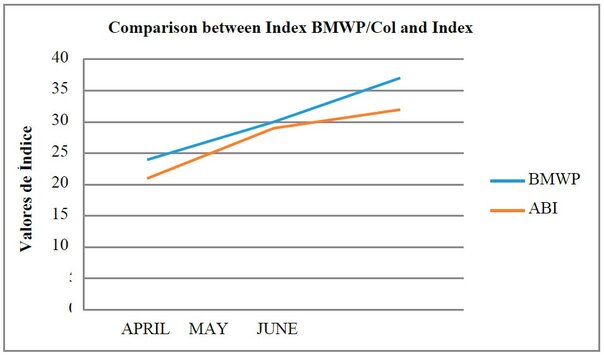
Figure 11. Comparison between BMWP and ABI indexes.
In Figure Nº11, it is shown that, in April, May and June, similar results were obtained between 21 and 37, proving that the two indices determine that the water quality is critical and, or doubtful.
IBF Index Analysis
In Table No. 18, the water quality values are displayed using the IBF index along with their respective classifications for each month of sampling (April, May, and June).

Table 18. Water quality through the IBF biological index.
In Table Nº 18, it is shown that in April, May, and June, similar values ranging from 3.021 to 3.033 were obtained, indicating a Class I rating. This means the water is of excellent quality, with no apparent organic contamination.
According to the application of the IBF index, in April, tolerant and sensitive families were identified, recording a sensitive family with a value of 6, the Hyalellidae family, followed by the tolerant families with values of between 3 and 1 those Notonectidae, Lymnaeidae, Cylicobdellidae, Glossiphoniida and Tubificidae.
In May, the most sensitive family recorded with a value of 8, the Libellulidae family and the least sensitive with a value of 6, the Hyalellidae family, and the pollution-tolerant families with values of between 3 and 1: Notonectidae, Tipulidae, Cylicobdellidae, Glossiphoniida and Tubificidae.
In the last monitoring carried out in June, 8 families were recorded, according to the tolerance value of the IBF index; a family with high sensitivity to pollution with a value of 8 was recorded, the Libellulidae family, with a value of 6, the family Hyalellidae that is less sensitive and the tolerant families with values of between 4 and 1: Cylicobdellidae, Notonectidae, Glossiphoniidae, Tubificidae, Lymnaeidae, Planariidae.
DISCUSSION
This research demonstrates the application of physical-chemical and microbiological analyses to calculate the Water Quality Index (WQI), specifically the National Foundation for Sanitation (NFS) Index and the DINIUS Index. These indices were applied to Santo Domingo Lagoon in Cotopaxi National Park, classifying water conditions during both rainy (April) and dry seasons (June) as poor and contaminated. These assessments were compared with current Ecuadorian legislation. It is worth noting that certain parameters analyzed are not specified in the bill (NE), making it challenging to determine compliance. For instance, dissolved oxygen levels fluctuate with seasonal changes.
It is recommended not to utilize the IBF index, as it is unsuitable for this type of lacustrine system studied in the research. Climatic factors such as precipitation and altitude contribute to the absence of the Ephemeroptera, Plecoptera, and Trichoptera (EPT) groups, which are considered water quality indicators. The substantial variations in flow during the studied months (April, May, and June) significantly reduced the number of species compared to months with lower water flow. It is essential to note that many organisms develop depending on the climatic conditions of the environment.
The most common and abundant species detected at the sampling points are Notonectidae, Cylicobdellidae, and Hyalellidae. Families found in lower abundance include Lymnaeidae, Glossiphoniidae, Tubificidae, Libellulidae, Tipulidae, and Planariidae. In total, 1071 aquatic macroinvertebrates have been collected and classified into 9 families. According to the BMWP, ABI, and IBF methods, which indicate the degree of pollution tolerance, the application of the BMWP index defined the conditions of the lagoon, evaluating each of the identified families based on the ecology of each order and family of macroinvertebrates with the guidance of 8, taking into account the matrix of sensitivity of aquatic macroinvertebrates BMWP/Col. (2008), SENAGUA-Ecuador, the result showed that the lagoon belongs to class III and IV, indicating critical water conditions, meaning heavily polluted waters, and class III in June, indicating questionable water quality, or moderately polluted waters.
Using the ABI index, adapted from the BMWP index for high mountain ranges due to similar values (Jacobsen, 2008), tolerance levels were assigned based on the morphological characteristics and habitat of each family of macroinvertebrates, about 8. Additionally, the matrix of sensitivity of aquatic macroinvertebrates ABI was complemented with the standardization project of tolerance levels of aquatic macroinvertebrates by SENAGUA - Ecuador, yielding similar results. It was demonstrated that the lagoon is in class IV, signifying poor water quality, i.e., highly polluted or critical waters. On the other hand, the IBF index was applied to determine organic pollution without needing specific organism identification 7.
Tolerance values for each identified family were also estimated with the help of 8. The sensitivity matrix of aquatic macroinvertebrates IBF and the standardization project of tolerance levels of aquatic macroinvertebrates by SENAGUA - Ecuador resulted in a class I rating, signifying excellent water conditions. Therefore, Santo Domingo Lagoon shows no apparent organic pollution.
The pollution tolerance values estimated through the applied techniques, utilizing four biotic indices (two quantitative - ETP and IBF, and two qualitative - BMWP and ABI), will serve as a basis for creating a guide to aquatic macroinvertebrates applicable in Ecuador. In contrast, less demanding organisms may be abundant but do not indicate a healthy environment, resulting in lower qualitative indices 9.
Research employing bioindicators and physical, chemical, and microbiological analyses has proven highly relevant in the research field. These tools aim to ensure the conservation of ecosystems and optimize economic resources for future investigations. Similar studies have been conducted, such as "Assessment of the Ecological Health of High-Altitude Lakes in Latin America" 10 which applied bioindicators and physical-chemical analyses, providing valuable information on the health of these ecosystems, and "Assessment of Biodiversity and Water Quality in Volcanic Lakes" 11 which focused on assessing water quality using bioindicators and physical-chemical analyses.
CONCLUSIONS
Through the application of the indexes NFS and DINIUS, it was determined that the water quality ranges from poor to contaminated. On the other hand, according to the BMWP/Col and ABI indexes, the water quality of Laguna Santo Domingo falls within Class III and IV, indicating critical, questionable, poor, and contaminated waters. However, the IBF Index established that the body of water falls into Class I, corresponding to water in excellent condition. Therefore, organic contamination is not apparent.
During the research period, 1071 aquatic macroinvertebrate individuals were collected and grouped into 9 families. The most representative groups were Notonectidae, Cylicobdellidae, and Hyalellidae. Environmental disturbances, such as the high altitude location and downstream position, directly and negatively affect the abundance of EPT families, one of the most sensitive groups to pollution. These environmental factors also contribute to the recent increase in abundance of those Lymnaeidae, Glossiphoniidae, Tubificidae, Libellulidae, Tipulidae, and Planariidae.
The application of indices and the physical-chemical and microbiological analyses will determine the water quality of Santo Domingo Lagoon, which is considered critical, poor, and contaminated. The results will enable the relevant authorities to propose strategies for improving the quality and conservation of water resources.
Through the application of the IBF index and based on the results obtained, the conclusion was reached that it contradicts the other water quality indices. Therefore, this index does not apply to this type of lake system.
REFERENCES
1.Segnini S. The use of benthic macroinvertebrates as indicators of the ecological condition of flowing water bodies. Ecotropics. In.: Universidad de LAF de CD de BL de E. de ILHMV; 2003. p. 16(2), 45 – 63.
2.Romero H. Contamination of water, soil and air. In. Barcelona: Herder; 2015.
3.(SIT) SIoT. Biological Question of Oxygen.. In.; 2006.
4.Carrera C, Fierro K. The aquatic macroinvertebrates as indicators of water quality: Monitoring manual.. In EcoScience. ; 2001; Quito - Ecuador. p. 67.
5.Brown, R., McCleland, N. Water Quality Index. Application in the Kansas River Ba-sin. In ; 1973.
6.Ríos Touma B., et Al. The Andean Biotic Index (ABI): revised tolerance to pollution values for macroinvertebrate families and index performance evaluation. In. España; 2014.
7.Resh VH, Myers MJ and Hannaford MJ. Macroinvertebrates as biotic indicators of environmental quality. In Methods in Stream Ecology. San Diego: In FR Hauer. y GA Lamberti; 1996. p. 647-668.
8.Roldán G. Bioindication of water quality in Colombia: Use of the BMWP/Col method. In. Colombia: University of Antioquia; 2003. p. 164.
9.SH D. Design of an Index of Water Quality., Water Resources Bulletin. In ; 1987. p. 833, 843.
10.Mandaville S. Benthic Macroinvertebrates in Taxa Tolerance Values, Metrics, and Protocols Soil & Water Conservation Society of Metro Halifax. In.; 2002.
11.Rosenberg, DM and Resh VH. Freshwater biomonitoring and benthic macroinvertebrates. In. New York: Chapman and Hall; 1993. p. 488.
12.Abdel Raouf, Homaidan, IBM Ibraheem. Microalgae and wastewater treatment. In.: Saudi Journal of Biological Sciences 19; 2012. p. 257-275.
13.American society for testing and materials. ABS (Annual book of Standards). 1994.
14.Determination of pH in water.. In Method ASTM D.; 1990. p. 1293-84.
15.Acosta R, Rieradevall M, Ríos B, Prat, N. Proposal of a protocol for evaluating the ecological quality of andean rivers (CERA) and its application to two watersheds in Ecuador and Peru. In.: Limnetica; 2009. p. 35-64.
16.Tercedor A. Aquatic macroinvertebrates and river water quality. In.; 1996.
17.Water Symposium in Andalucía (SIAGA). In Memorias IV. Almeria Nº2 p. 203-213.
18.Alba Tercedor, Sanchez O. A quick and simple method to evaluate the biological quality of running water based on Hellawell. In.; 1988.
19.Arocena R, Conde D. Methods in Ecology of Continental Waters, with Examples of Limnology in Uruguay. In. Montevideo: DIRAC/FC/UDELAR; 1999. p. 233.
20.512-89 A. Standard Test Methods for Chloride Ion in Water. In. Hiladelphia PA: American Society for Testing and Materials, USA, ASTM Committee on Standards; 1989. p. 481-484.
21.Brenes R RL. The water: its properties and its biological importance. In ; 2015.
22.Chapman D. Water Quality Assessments: A Guide to the Use of Biota, Sediments and Water in Environmental Monitoring.. In ; Chapman, D; London. p. 626.
23.I C. Development of a biotic index to evaluate the ecological quality of water. In ; 2000.
24.I C. Development of a biotic index to evaluate the ecological quality of water. In ; 2000.
25.Sh D. Social Accounting System for Evaluating Water Resources. In ; 1972; Water 2. , vol 8, no. 5, October 1972, pp. : Resources Research. p. 1159 – 1177.
26.Domínguez L., Goethals P. and De Pauw N. Aspects of the physicochemical environment of the Chaguana river: a first step in the use of benthic macroinvertebrates in the evaluation of water quality.. In ; 2005: ESPOL Technological Journal. p. 127-134.
27.W H. Rapid Field Assessments of Organic Pollution With A Family Level. In ; 1988.
28.Biotic Index. In Journal Of The North American Benthological Society. ; USA.
29.INEC. Population by sex, according to province, parish and registration district. [Online].; 2010 [cited 2023 10 15. Available from: http://www.ecuadorencifras.gob.ec/documentos/web- inec/Tabulados_CPV_2010.
30.INEN. In Standard Ecuadorian NTE INEN 2.; 1998. p. 169, 98.
31.A J. Macroinvertebrates: composition, life histories and production. In Tropical stream ecology, chapter 4.; 2008.
32.MAE. [Online].; 2017. Available from: http://suia.ambiente.gob.ec/documents/10179/1232803/Reporte+Registro+Visitas+2017+%28 hasta+septiembre%29.pdf/2d336694-0d3e-4d1b-8698-d5628fe03b37.
33.R M. Ecology. In.; 1991. p. 951.
34.ORGANIZATION PH. Guide lines for Drinking Water Quality, criteria relative to the health and other information base. In World Health Organization. Washington DC: Scientific Publication N° 506; 1987.
35.W O. Environmental indices, theory and practice, AA science, Ann Arbor. In. Michigan; 1978.
36.Ryding, S & Rast, W. The Control of Eutrophication in Lakes and Marshes. In.; 1992.
37.Madrid and UNESCO. In. Paris: Pirámide p. 375.
38.Shuval, IH et al.. Health effects of nitrates in water.. In.: EPA; 1977. p. 600/1-1-77-030.
39.Simboni Ruiz, N., Carvajal, Y. & Escobar, J. Revision of physicochemical parameters as indicators of water quality and contamination. In Engineering and Research.: National University of Colombia; 2007. p. 172-181.
40.SNET. Proposals for the decontamination of the rivers Acelhuate, Sucio and Suquiapa. In.; 2002.
41.National Service of Territorial Studies. In.
42.Valenzuela J. Exploration of possibilities to propose a train of treatments for hardness removal that achieves technical and economic optimization of the process. In. Mexico: Universidad de las Americas Puebla; 2004. p. 12-20.
43.Vázquez G., Castro G., González I., Pérez R. & Castro T.. Bioindicators as tools to determine water quality. In.; 2006. p. 7.
Received: October 9th 2023/ Accepted: January 15th 2024 / Published:15 February 2024
Citation: Ceballos Peñafiel K N, Quishpe Guanoluisa M A. Determination of water quality through using bioindicators, physical-chemical and microbiological analysis of the lagoon Santo Domingo of the national park Cotopaxi, province of Pichincha, period 201
Additional information Correspondence should be addressed to [email protected]
Peer review information. Bionatura Journa thanks anonymous reviewer(s) for their contribution to the peer review of this work using https://reviewerlocator.webofscience.com/
All articles published by Bionatura Journal are made freely and permanently accessible online immediately upon publication, without subscription charges or registration barriers.
Publisher's Note: Bionatura Journa stays neutral concerning jurisdictional claims in published maps and institutional affiliations.
Copyright: © 2024 by the authors. They were submitted for possible open-access publication under the terms and conditions of the Creative Commons Attribution (CC BY) license (https://creativecommons.org/licenses/by/4.0/).
